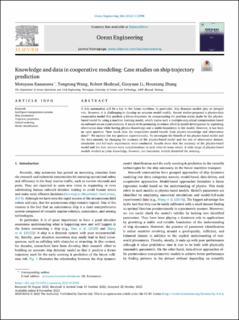| dc.contributor.author | Kanazawa, Motoyasu | |
| dc.contributor.author | Wang, Tongtong | |
| dc.contributor.author | Skulstad, Robert | |
| dc.contributor.author | Li, Guoyuan | |
| dc.contributor.author | Zhang, Houxiang | |
| dc.date.accessioned | 2022-11-15T10:51:54Z | |
| dc.date.available | 2022-11-15T10:51:54Z | |
| dc.date.created | 2022-11-09T10:05:16Z | |
| dc.date.issued | 2022 | |
| dc.identifier.citation | Ocean Engineering. 2022, 266, part 4, . | en_US |
| dc.identifier.issn | 0029-8018 | |
| dc.identifier.uri | https://hdl.handle.net/11250/3031877 | |
| dc.description.abstract | A ship automation will be a key to the future maritime. In particular, ship dynamic models play an integral role. However, it is challenging to develop an accurate model readily. Recent studies proposed a physics-data cooperative model that predicts a future trajectory by compensating for position errors made by the physics-based model by using a machine learning model, which learns such a multiple-step-ahead compensation based on onboard sensor measurements. It seems to be promising to reduce effort in model development by exploiting observation data while having physics knowledge and a stable foundation in the model. However, it has been an open question “how much does the cooperative model benefit from physics knowledge and observation data?”. We tackled this key question experimentally. To investigate the benefit of the physics-based model and the data amount, by changing the accuracy of the physics-based model and the size of observation dataset, simulation and full-scale experiments were conducted. Results show that the accuracy of the physics-based model and the data amount were complementary to each other to some extent. A wide range of physics-based models worked as prior knowledge, however, too inaccurate models disturbed the training. | en_US |
| dc.language.iso | eng | en_US |
| dc.publisher | Elsevier Science | en_US |
| dc.rights | Navngivelse 4.0 Internasjonal | * |
| dc.rights.uri | http://creativecommons.org/licenses/by/4.0/deed.no | * |
| dc.title | Knowledge and data in cooperative modeling: Case studies on ship trajectory prediction | en_US |
| dc.title.alternative | Knowledge and data in cooperative modeling: Case studies on ship trajectory prediction | en_US |
| dc.type | Peer reviewed | en_US |
| dc.type | Journal article | en_US |
| dc.description.version | publishedVersion | en_US |
| dc.source.volume | 266 | en_US |
| dc.source.journal | Ocean Engineering | en_US |
| dc.identifier.doi | https://doi.org/10.1016/j.oceaneng.2022.112998 | |
| dc.identifier.cristin | 2071016 | |
| dc.source.articlenumber | 112998 | en_US |
| cristin.ispublished | true | |
| cristin.fulltext | original | |
| cristin.qualitycode | 1 | |

